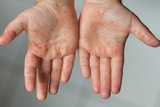

It’s important to be on the lookout for hand, foot and mouth disease, a common childhood illness most often seen in the summer and fall. No, it is not the foot and mouth disease that affects animals — this one gets its name from a distinctive rash that appears on the hands, on the feet and in the mouth.
What does hand, food and mouth disease look like?
The rash manifests as tiny red bumps or blisters on the palms of the hands, soles of the feet, fingers and toes. In the mouth, the rash appears as painful sores or ulcers mainly clustered in the back of the throat. But the rash does not necessarily appear in all three areas, and can appear on the arms and legs as well as on the buttocks.
In addition to rashes, children often have a fever for the first few days of the illness. Some also have loose stools. Although the skin rash can be a slightly tender nuisance, the mouth sores can be so painful that children refuse to eat or drink.
How to treat hand, foot and mouth disease
While there is no specific cure for hand, foot and mouth disease, you can keep your child comfortable until the illness resolves by following these tips:
- Treat mouth pain so that your child drinks well and avoids dehydration. Acetaminophen (e.g., Tylenol®) and ibuprofen (e.g., Motrin®, Advil®) are effective pain medicines.
- For toddlers and older kids, offer soft foods such as yogurt, pasta, pudding or smoothies as well as ice pops to provide sustenance and relieve pain.
- Offer your child a variety of fluids, keeping in mind if your child is not eating, water alone does not provide energy for the body nor does it provide the salt needed to maintain blood pressure.
The worst of the mouth pain typically occurs during the first three to five days of illness. Antibiotics and other medications do not kill this virus.
Tips to prevent hand, foot and mouth disease
The coxsackie virus that causes hand, foot, and mouth disease is mainly spread through saliva and stool. This is why it often affects toddlers: Kids in this age group often touch other children or share toys and then put their hands in their mouths. The best way to limit the spread of the virus is through frequent handwashing.
Adults can get hand, foot and mouth disease too, so you should also wash your hands frequently, both while caring for your child and after changing diapers.
How long is it contagious?
Like most childhood viruses, it is difficult to pinpoint exactly when kids with hand, foot and mouth disease are no longer contagious. We do know that children can spread hand, foot and mouth disease starting the day before the rash shows up and for several days after the rash appears.
As long as children do not have a fever and otherwise are acting like themselves, most child care centers do not exclude children with the assumption that good handwashing is routinely practiced.
When to call the pediatrician
Most of the time, children do well with this virus. Not all children have pain, and the rash needs no treatment. Keep children home from school until their fever and pain resolve. They do not have to stay home until the rash resolves, which can take one to two weeks.
Call your child’s healthcare provider if:
- You need help diagnosing your child’s illness.
- Your child is not drinking enough and is showing signs of dehydration, such as decreased urination (no wet diaper in the last six to eight hours), dry lips and mouth, no tears while crying, or dark yellow urine.
- Your child’s fever lasts three or more days.
- Your child is in a lot of pain.
- Your child shows a change in mental state (i.e., they are lethargic, fail to interact with you in their usual manner, or become difficult to awaken).
- You have any concerns.
Featured in this article
Experts

It’s important to be on the lookout for hand, foot and mouth disease, a common childhood illness most often seen in the summer and fall. No, it is not the foot and mouth disease that affects animals — this one gets its name from a distinctive rash that appears on the hands, on the feet and in the mouth.
What does hand, food and mouth disease look like?
The rash manifests as tiny red bumps or blisters on the palms of the hands, soles of the feet, fingers and toes. In the mouth, the rash appears as painful sores or ulcers mainly clustered in the back of the throat. But the rash does not necessarily appear in all three areas, and can appear on the arms and legs as well as on the buttocks.
In addition to rashes, children often have a fever for the first few days of the illness. Some also have loose stools. Although the skin rash can be a slightly tender nuisance, the mouth sores can be so painful that children refuse to eat or drink.
How to treat hand, foot and mouth disease
While there is no specific cure for hand, foot and mouth disease, you can keep your child comfortable until the illness resolves by following these tips:
- Treat mouth pain so that your child drinks well and avoids dehydration. Acetaminophen (e.g., Tylenol®) and ibuprofen (e.g., Motrin®, Advil®) are effective pain medicines.
- For toddlers and older kids, offer soft foods such as yogurt, pasta, pudding or smoothies as well as ice pops to provide sustenance and relieve pain.
- Offer your child a variety of fluids, keeping in mind if your child is not eating, water alone does not provide energy for the body nor does it provide the salt needed to maintain blood pressure.
The worst of the mouth pain typically occurs during the first three to five days of illness. Antibiotics and other medications do not kill this virus.
Tips to prevent hand, foot and mouth disease
The coxsackie virus that causes hand, foot, and mouth disease is mainly spread through saliva and stool. This is why it often affects toddlers: Kids in this age group often touch other children or share toys and then put their hands in their mouths. The best way to limit the spread of the virus is through frequent handwashing.
Adults can get hand, foot and mouth disease too, so you should also wash your hands frequently, both while caring for your child and after changing diapers.
How long is it contagious?
Like most childhood viruses, it is difficult to pinpoint exactly when kids with hand, foot and mouth disease are no longer contagious. We do know that children can spread hand, foot and mouth disease starting the day before the rash shows up and for several days after the rash appears.
As long as children do not have a fever and otherwise are acting like themselves, most child care centers do not exclude children with the assumption that good handwashing is routinely practiced.
When to call the pediatrician
Most of the time, children do well with this virus. Not all children have pain, and the rash needs no treatment. Keep children home from school until their fever and pain resolve. They do not have to stay home until the rash resolves, which can take one to two weeks.
Call your child’s healthcare provider if:
- You need help diagnosing your child’s illness.
- Your child is not drinking enough and is showing signs of dehydration, such as decreased urination (no wet diaper in the last six to eight hours), dry lips and mouth, no tears while crying, or dark yellow urine.
- Your child’s fever lasts three or more days.
- Your child is in a lot of pain.
- Your child shows a change in mental state (i.e., they are lethargic, fail to interact with you in their usual manner, or become difficult to awaken).
- You have any concerns.

Symptom Checker
Use this symptom checker to learn how serious your child's symptoms are, if a healthcare visit is needed, what steps you can take to relieve symptoms at home.